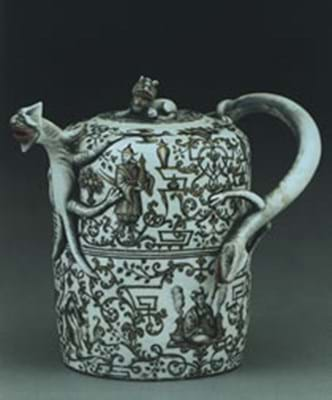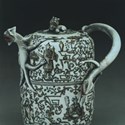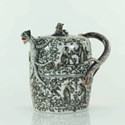These cylindrical-shaped pots with reptilian spouts and handles owe their form to Chinese blanc de chine originals but their distinctive hausmaler schwarzlot painting featuring Oriental figures and animals amongst curling tendrils has no Far Eastern parallel and puts them into a small group of just three known examples.
One of these, shown Below right, turned up at Sotheby's main summer sale of English and Continental ceramics on June 2 as part of a small but select 11-lot single-owner consignment.
The other two were once in the celebrated collection of Otto and Magdelena Blohm and were sold by Sotheby's in 1961. One of the Blohm duo, the tallest of the trio with a silver cover, resurfaced again at a Christie's auction four years later. The other, above right, remained in the Blohm family having been purchased in the 1961 sale by their daughter Beatrice Blohm von Rumohr and will be offered for sale again next Monday, June 27, at Christie's King Street as part of a 103 lot consignment of Blohm pieces that belonged either to Beatrice or her brother Ernesto Blohm.
Although the teapots are very similar, there are slight differences. Christie's version is just a shade shorter at 51/4in (13.3cm). Sotheby's reptiles have more stripes and dots to their bodies and the Oriental figures are not disposed in the same way around the body of the pots. But the biggest distinction has come with the cataloguing. Sotheby's followed the time-honoured attribution of this group ascribing theirs to the Viennese Du Pacquier factory and dated it to c.1725. Christie's, on the other hand, have bucked tradition and have opted for an attribution to "almost certainly Böttger" and dated theirs to c.1720 - that is porcelain made at Meissen during the lifetime of the arcanist Johann Böttger.
Meissen or Du Pacquier? Where both houses share more common ground is that the schwarzlot painting was executed in the outside decorating workshop of Ignaz Preissler of Breslau and this wonderfully fanciful riot of baroque detailing is surely the teapots' chief glory.
Sotheby's pot, which has chips to the cover rim and to the seated lion knop and a restored lizard's head, carried an estimate of £80,000-120,000. Christie's pot, which has a broken and restuck handle, a cover rim chip and small areas of restoration is guided at just £18,000-25,000.
Early this month Sotheby's model comfortably outstripped its estimate after competition from the phones and the room selling for £210,000, a very strong price that is up there with the highest sums paid at auction for Du Pacquier. The buyer was Dr Johan Kraeftner, director of the Leichtenstein Museum who famously paid £17m for the Badminton Cabinet last December. With plenty of competition for Sotheby's example and several disappointed underbidders the big question now is, what will Christie's version make?
Anne Crane
Seeing double
YOU wait forever then two come along at once. The sentiment so often expressed about London buses could equally well apply to rare early 18th century Continental porcelain teapots.








